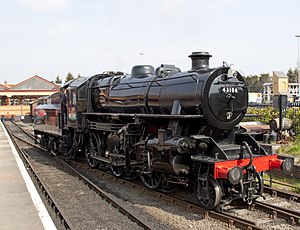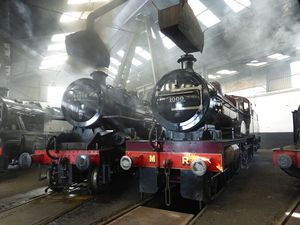LMS Ivatt Class 4 43106
43106 is the only surviving example of an LMSLondon Midland & Scottish Railway IvattHenry George Ivatt, Chief Mechanical Engineer (CME) of the London, Midland and Scottish Railway 1946-1948. CME of BR (London Midland Region) 1948-1951 Class 4 2-6-0 Mogul, and is affectionately referred to on the SVRSevern Valley Railway as “The Flying Pig” (often shortened to "The Pig"). It is owned by the Ivatt Class 4 Group.
43106 in service
The IvattHenry George Ivatt, Chief Mechanical Engineer (CME) of the London, Midland and Scottish Railway 1946-1948. CME of BR (London Midland Region) 1948-1951 Class 4 locomotives were mainly designed for medium freight work but were also widely used on secondary passenger services. They were classified as 4MTThe British Railways system of classifying steam locomotives by power using a number from 0, least powerful, to 9, most powerful, followed by either F for freight, P for Passenger or MT for Mixed Traffic. by BRBritish Rail or British Railways. The unusual design with raised running plates led to members of the class being referred to by nicknames such as “Doodlebug” or “Flying Pig”.
Although an LMSLondon Midland & Scottish Railway design, 43106 was built after nationalisation by BRBritish Rail or British Railways at the former LNERLondon & North Eastern Railway Darlington Works. The locomotive entered service at South Lynn, Norfolk in April 1951 where it remained for 5 years. Whilst operating in East Anglia it carried Whitaker token exchange apparatus fitted into a "pocket" towards the front of the tender. Most of the tooling to reproduce the apparatus this locomotive carried whilst there has been made.
After closure of the former Midland & Great Northern Joint Railway, 43106 was transferred to Woodford Halse on the former Great Central Railway for a period of six years, before spending the rest of her working life at ex-LMSLondon Midland & Scottish Railway sheds in the Midlands and North West. Her longest allocation during this time was two years eleven months at Heaton Mersey, from 1963 to 1966. Following a spell of just over a year at Carlisle, she was allocated to her final shed, Lostock Hall, in September 1967.[1] After suffering a minor derailment at Colne in April 1968,[2] 43106 was withdrawn from service in June 1968 after a relatively short working life of 17 years 2 months.[3]
43106 in preservation
43106 was one of the SVRSevern Valley Railway’s early locomotives, arriving ‘light engine’ direct from Lostock Hall in August 1968. It worked services on the official opening day in May 1970, and in 1975 took part in the Rail 150 celebrations at Shildon, travelling there in steam behind 48233. 43106 also hauled several main line railtours during the 1980s.
Her recent overhaul was completed in 2009. A more recent intermediate overhaul saw work carried out on the boiler which allowed a new 10 year certificate to be issued along with a completely new loco dragbox.
Since returning to service, 43106 has been a regular on the SVRSevern Valley Railway as well as appearing at gala events on other heritage railways. In September 2015, 43106 appeared at the LMSLondon Midland & Scottish Railway themed gala at Barrow Hill, becoming the first of her class to appear at the Roundhouse in half a century.
Sources
- ↑ BRDatabase retrieved 27 January 2015.
- ↑ Nabarro, G (1971), Severn Valley Steam, p71
- ↑ BRDatabase retrieved 27 January 2015.
See also
Steam Locomotives
The Severn Valley Railway on the main line

